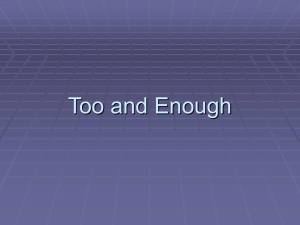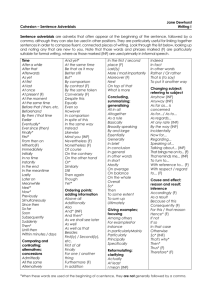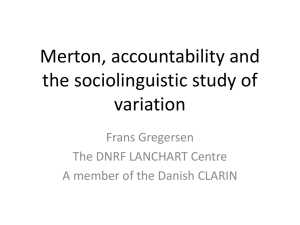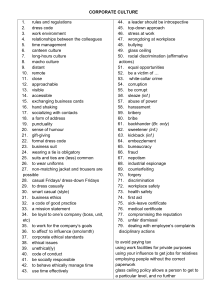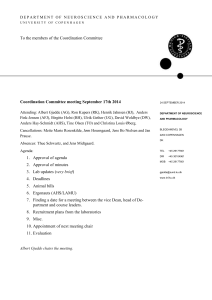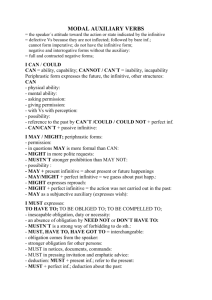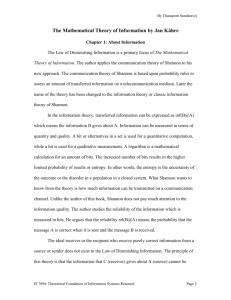ECON 302C
advertisement
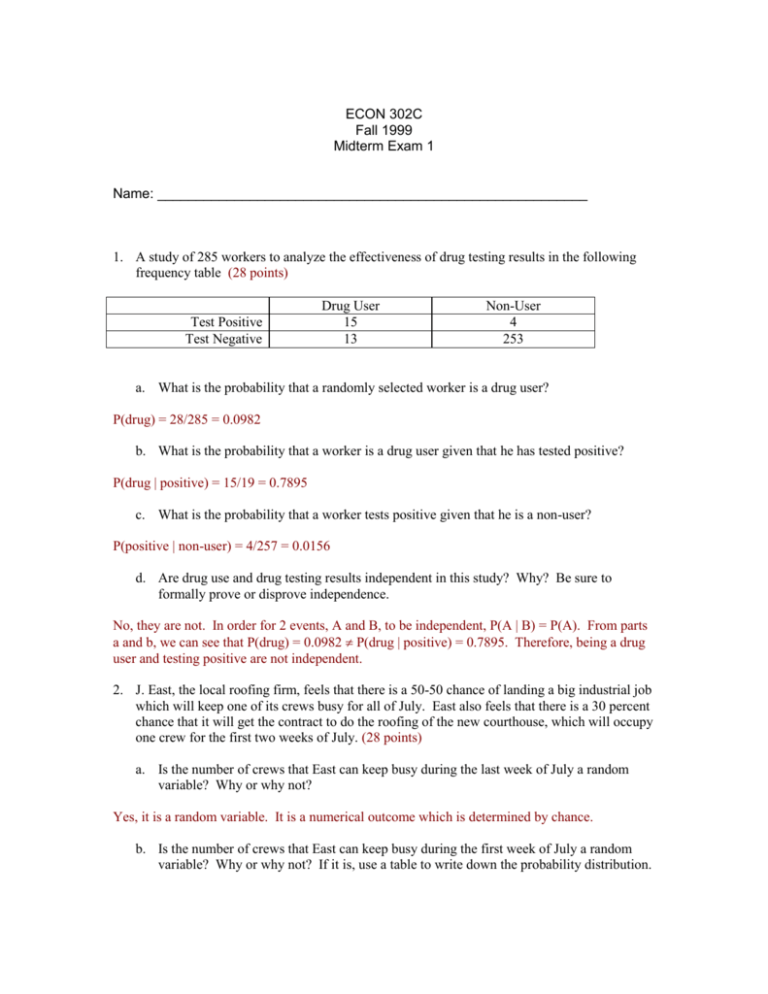
ECON 302C Fall 1999 Midterm Exam 1 Name: ________________________________________________________ 1. A study of 285 workers to analyze the effectiveness of drug testing results in the following frequency table (28 points) Test Positive Test Negative Drug User 15 13 Non-User 4 253 a. What is the probability that a randomly selected worker is a drug user? P(drug) = 28/285 = 0.0982 b. What is the probability that a worker is a drug user given that he has tested positive? P(drug | positive) = 15/19 = 0.7895 c. What is the probability that a worker tests positive given that he is a non-user? P(positive | non-user) = 4/257 = 0.0156 d. Are drug use and drug testing results independent in this study? Why? Be sure to formally prove or disprove independence. No, they are not. In order for 2 events, A and B, to be independent, P(A | B) = P(A). From parts a and b, we can see that P(drug) = 0.0982 P(drug | positive) = 0.7895. Therefore, being a drug user and testing positive are not independent. 2. J. East, the local roofing firm, feels that there is a 50-50 chance of landing a big industrial job which will keep one of its crews busy for all of July. East also feels that there is a 30 percent chance that it will get the contract to do the roofing of the new courthouse, which will occupy one crew for the first two weeks of July. (28 points) a. Is the number of crews that East can keep busy during the last week of July a random variable? Why or why not? Yes, it is a random variable. It is a numerical outcome which is determined by chance. b. Is the number of crews that East can keep busy during the first week of July a random variable? Why or why not? If it is, use a table to write down the probability distribution. Yes, again it is a numerical outcome determined by chance. The probability distribution is as follows: X 0 1 2 P(X) 0.35 0.5 0.15 c. What is the expected number of crews that East can keep busy during the first week of July? E(X) = 0*.35 + 1*.5 + 2*.15 = 0.8 d. Suppose East will get a profit of $25,000 per week for each crew that is working during the week. What is East’s expected profit for the first week of July? E(profit) = E(25000*X) = 25000*E(X) = $20,000 3. Suppose Al was interested in studying whether death rates depended on state-level influences. When he looks at the data, he notices that Florida has a much higher death rate than do most other states. He therefore concludes that the climate of Florida is very unhealthy. Do you agree? (18 points) No, Al is confusing causality with correlation. Just because high death rates and a warm climate are correlated does not mean that warm temperatures cause death (nor, of course, does it mean that many people dying cause the temperature to rise). Most likely, the correlation stems from the fact that many elderly people retire to Florida, and that death rates are highest among the elderly. 4. On the basis of past experience, the buyer for a large sports store estimates that the number of bicycles sold next year will be somewhere between 40 and 90, with the following distribution: (28 points) x 40 50 60 70 80 90 P(x) .05 .15 .41 .34 .04 .01 a. Verify that this is a proper probability distribution. In order to verify that this is a proper probability distribution, we must check that the probabilities sum to one and that each probability is between zero and one. These two conditions are met, so it is a proper probability distribution. b. What is the expected number of bicycles sold? E(X) = 62 c. What is the variance of X? V(X) = 90 d. What is the probability that the number of bicycles sold is less than 70 but more than 40? P(40<X<70) = P(50) + P(60) = 0.56 5. Mary believes that if she is to be admitted to the graduate school of her choice, she must get an “A” in statistics, microeconomics and macroeconomics. If she does this, she will be admitted. She estimates that the probability of her getting less than an “A” in any one of these subjects is 2/3, and she believes that her grade in any one of the subjects is statistically independent of her grades in the other two. (32 points) a. What is the probability that she gets an “A” in both statistics and microeconomics? P(stats and micro) = P(stats) * P(micro) = 1/3 * 1/3 = 1/9, since stats and micro are independent. b. What is the probability that she gets an “A” in at least one of the three courses? P(at least one A) = 1-P(not stats and not micro and not macro) = 1-(2/3)3 = 19/27 c. What is the probability that she gets an “A” in statistics given that she gets an “A” in microeconomics? P(stats | micro) = P(stats) =1/3, because stats and micro are independent. d. What is the probability that she gets admitted to the graduate school of her choice? P(stats and micro and macro) = (1/3)*(1/3)*(1/3) = 1/27 6. Statisticians have consistently spoken-out against mandatory AIDS testing. Their argument is based upon the following. Estimates are that .6 percent (.006) of the population has the disease. We also know that the test will correctly identify an infected person 99.9 percent (.999) of the time and an uninfected person will test positive 1 percent of the time (.01). (32 points) a. What is the probability that I test negative given that I am not infected? P(neg | not inf) = 1- P(pos | not inf) = 1 - 0.01 = 0.99 b. What is the probability that I have AIDS given that I test positive? P(inf | positive) = P( pos | inf) * P(inf) [ P( pos | inf) * P(inf) P( pos | not inf) * P(not inf)] .999 * .006 P(inf | positive) 0.374 .999 * .006 .01 * .994 c. What is the probability that I don't have AIDS given that I test negative? P(neg | not inf) * P(not inf) [ P(neg | not inf) * P(not inf) P(neg | inf) * P(inf)] .99 * .994 .999999 P(not inf | negative = .99 * .994 .001 * .006 P(not inf | negative) = d. So what do you think about mandatory AIDS testing given your results from above (briefly explain)? Mandatory AIDS testing is unreliable because such a large number of positive test results are incorrect. In fact, given that you have a positive test, there is less than a 50-50 chance (a lower probability than a simple coin flip) that you are actually infected with the AIDS virus. Considering the enormous stigma associated with a positive AIDS test, it does not seem wise to mandate AIDS testing. 7. Jim and Cathy are two real estate agents. Let X denote the number of houses that Jim will sell in a week, and let Y denote the number of houses that Cathy will sell in a week. Suppose the joint probability distribution of X and Y is shown in the following table: (34 points) X Y 0 1 2 0 .12 .21 .07 1 .42 .03 .05 2 .06 .03 .01 a. What is the marginal probability distribution of X? X 0 1 2 P(X) .4 .5 .1 b. What is the conditional probability distribution of X given that Y=1? X 0 1 2 P(X|Y=1) .777 .111 .111 c. Are X and Y statistically independent? Formally prove or disprove. No, they are not. Two random variables, X and Y, are statistically independent if the marginal probability distribution of X is equal to the conditional probability distribution of X given Y for all X’s and Y’s. Parts a and b show that this condition is not met; therefore, the two events are not independent. d. Suppose that Jim and Cathy are the only two agents in the Hamilton Real Estate Agency. What is the expected value of the total number of homes that the agency sells in a week? E(X) = 1.23
